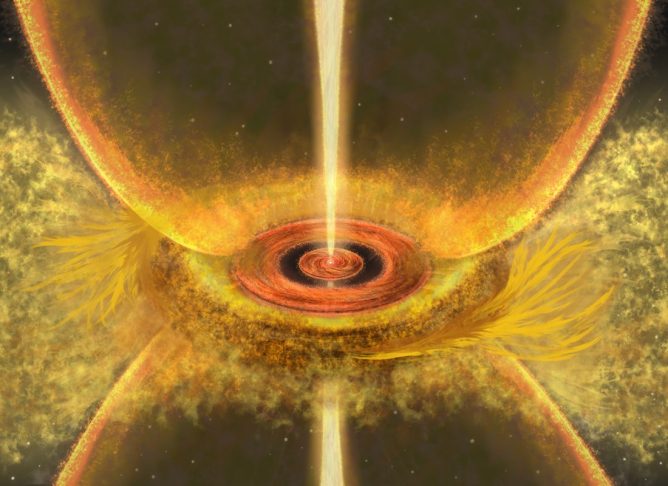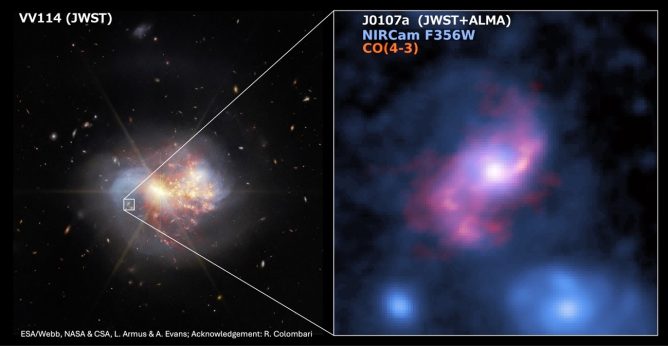Overview
A research team led by Hauyu Baobab Liu at the Academia Sinica Institute of Astronomy and Astrophysics (ASIAA) used the Atacama Large Millimeter/submillimeter Array (ALMA) to observe a large molecular gas clump [1] named G33.92+0.11, where a cluster with massive stars, called an OB association, is forming. ALMA allowed to reveal, in unprecedented detail, the fine structure of the molecular gas structures at the center of the region, where two surprisingly large molecular gas arms with sizes of ~1 pc [2], appear to be spiraling around two massive molecular cores. These results, which were made possible by the excellent imaging power of ALMA, showed that the large molecular arms are indeed the cradles of dense cores, which are current or future birthplaces of massive stars. These results represent a crucial step forward in the understanding of how mass distributes to form both massive cores and massive stars.
Research Background
How the gravitationally bound stellar clusters, for example, the young massive clusters (YMCs) and globular clusters (GCs) come to the existence, remains a fundamental problem in astrophysics. To form such complex systems, it is required that massive amounts of gas can be converted with little losses, into stars, before they start to disperse the gas by the action of their winds –the so called stellar feedback–, and such process is far from trivial. Current models propose that in order to quench the action of stellar feedback, the global collapse of the parent molecular cloud has to be very rapid. However, this global collapse of giant [3] molecular clouds (GMC) represents an observational challenge for astronomers, because they cannot measure distances along their line of sight (data is projected in two dimensions) and because it is near impossible to measure gas velocities in the transverse directions. Nevertheless, the amplified effects of the initial rotation (angular momentum) of the clouds may translate into the formation of massive molecular clumps that are supported by centrifugal forces at the center of the collapsing GMC. The identification of rotating structures at scales larger than the cores, may serve as evidence of such an outcome of global collapse. Also, because the massive molecular clumps are the densest regions in a collapsing GMC, they are likely the sites where the most massive stars of stellar clusters can form. To resolve the details of the morphology and kinematics of these systems will be key to understand how mass distributes in the sites of star cluster formation, such that it can form both massive and not massive stars.
ALMA Observations
A research team led by Hauyu Baobab Liu at the Academia Sinica Institute of Astronomy and Astrophysics (ASIAA) observed the luminous OB cluster-forming region G33.92+0.11, located at a distance of 7 kiloparsecs (about 23 thousand light years), with ALMA. This source is at a beginning phase of forming an OB association, which has a contained luminosity of 250 thousand times the luminosity of the Sun. Most of this light is provided by a few embedded massive stars. The research team used the archival Herschel 350 μm, which were combined with another 350 μm image from the Caltech Submillimeter Observatory (CSO) with a higher angular resolution.
“The Herschel Space Telescope archive images provided a high quality map of the 350 μm thermal emission of the external dusty gas structures around G33.92+0.11. We completed the missing small-scale pixels of this map with data from the Caltech Submillimeter Observatory. The final map revealed two molecular arms twisted in opposite directions, north and south of the cluster, converging at the central molecular clumps, indicating that perhaps the gas is being transported toward the central cluster along these spiral arms from distances as large as 20 light years.” says co-author Román-Zúñiga.

Figure 1: The central part of the OB cluster-forming region G33.92+0.11, observed by ALMA. Left: Dust continuum image taken at 1.3 mm. Right: False color image showing the integrated emission of three molecules: CH3CN in yellow, 13CS in green, and DCN in magenta, respectively. The CH3CN emission mainly traces the hot molecular cores, which harbor massive stars. The 13CS emission traces warm dense gas and shocks. The DCN emission appears to follow the bulk of dense gas traced by the dust continuum emission. Credit: ALMA(ESO/NAOJ/NRAO), H. B. Liu et al.
ALMA is an instrument suitable for probing into the detailed gas morphology and kinematics of G33.92+0.11 A, because it provides unprecedented high angular resolution and high imaging fidelity. ALMA observations towards G33.92+0.11 A, revealed two centrally located massive molecular cores (~100-300 solar masses), connected by several spiraling dense molecular gas arms. This kind of morphology resembles the previous ALMA images of molecular gas arms surrounding the low-mass protostellar binary L1551 NE [4], however, but linearly scaled-up by a factor between 100 and 1000 (Figure 2). In addition, the observed gas arms in G33.92+0.11 A appear to be fragmenting, which results in the formation of multiple satellite cores orbiting the central two highest mass cores. Comparing the simultaneously observed molecular gas tracers including CH3CN, 13CS, and DCN shows that the gas excitation conditions in these molecular arms and cores far from being uniform across the system (Figure 1). For instance, the two highest mass cores at the center already harbor massive stars and present bright CH3CN emission. The molecular arms embedded with satellite cores in the north may be relatively cool, indicated by the good correlation between the DCN line and the 1.3 mm dust continuum emission. Finally the molecular arms connecting the central massive molecular cores from the west may contain gas that is shocked to a higher temperature or are subject to stellar heating and show stronger 13CS emission.
This team propose that the central ~1 pc scale region of G33.92+0.11 A is a flattened, massive molecular clump that is currently accreting material, which is being fed by the exterior gas filaments, and is marginally supported by centrifugal forces. At all spatial scales, the regions of higher density, that contain larger amounts of mass, form at the center of the system. Accretion may be prohibited by the angular momentum, but might be alleviated by fragmentation. The authors further propose that in the dense eccentric accretion flows, the formation of spiraling arm-like structures may be essential to the process. The subsequent fragmentation of the dense molecular arms may lead to the formation of the second generation high-mass stars.
“Gas structures similar to spiral arms should be common in many systems at many different scales, as long as they are unstable to gravity and have non-negligible rotation. The superb images made with ALMA are starting to show this.” says co-author Galván-Madrid.
Notes
[1] In our nomenclature, massive molecular clumps refer to dense molecular gas structures with sizes of ∼0.5-1 pc, massive molecular cores refer to the










